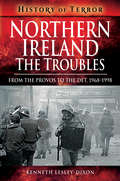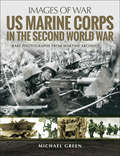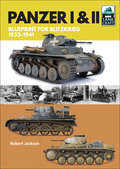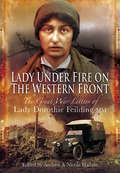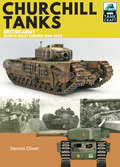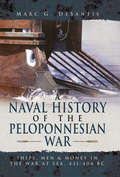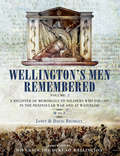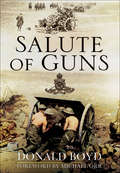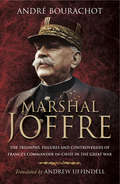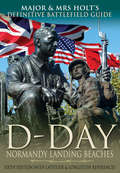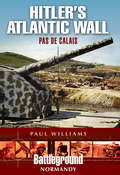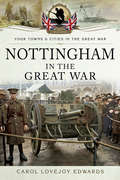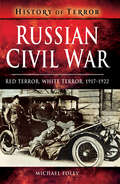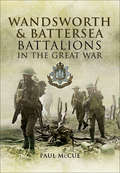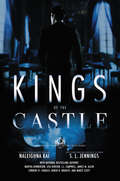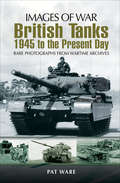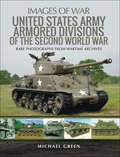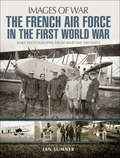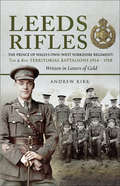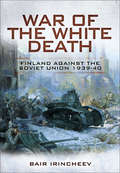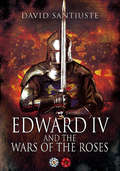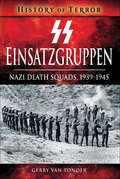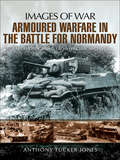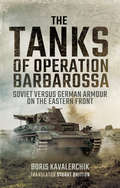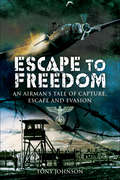- Table View
- List View
Northern Ireland: From The Provos to The Det, 1968–1998 (History of Terror)
by Kenneth Lesley-DixonIt is, of course, no secret that undercover Special Forces and intelligence agencies operated in Northern Ireland and the Republic throughout the troubles, from 1969 to 2001 and beyond. What is less well known is how these units were recruited, how they operated, what their mandate was and what they actually did. This is the first account to reveal much of this hitherto unpublished information, providing a truly unique record of surveillance, reconnaissance, intelligence gathering, collusion and undercover combat.An astonishing number of agencies were active to combat the IRA murder squads (the Provos), among others the Military Reaction Force (MRF) and the Special Reconnaissance Unit, also known as the 14 Field Security and Intelligence Company (The Det), as well as MI5, Special Branch, the RUC, the UDR and the Force Research Unit (FRU), later the Joint Support Group (JSG)). It deals with still contentious and challenging issues as shoot-to-kill, murder squads, the Disappeared, and collusion with loyalists. It examines the findings of the Stevens, Cassel and De Silva reports and looks at operations Loughgall, Andersonstown, Gibraltar and others.
US Marine Corps in the Second World War: Rare Photographs From Wartime Archives (Images of War)
by Michael GreenThe United States Marine Corps played a leading role in the war against Japan from Pearl Harbor in December 1941 until VJ Day on September 2, 1945. Living up to its motto the "First to Fight," the 1st Marine Division landed on the Japanese-occupied island of Guadalcanal in the south Pacific on August 7, 1942 and fought its way up the central Solomon Island to Cape Gloucester in the territory of New Guinea.In October 1942, the Marine Corps captured Tarawa Atoll and so began their advance across the central Pacific, fighting many famous and bloody battles such as Saipan, Tinian, Guam, Iwo Jima, and finally the 82-day epic struggle for Okinawa. These victories came at high cost, with 19,737 Marine killed and 67,207 wounded.This classic Images of War title presents a graphic overview of the Corps' legendary campaign in text and contemporary images. The author expertly describes the full range of Marine Corps weaponry and explains their organization, tactics, and fighting doctrine.
Panzer I & II: Blueprint for Blitzkrieg, 1933–1941 (TankCraft #7)
by Robert JacksonThe Panzer I and II played a significant part in the blitzkrieg campaigns that brought Germany such extraordinary success in the early years of the Second World War, and this highly illustrated volume in the TankCraft series is the ideal introduction to them.The Treaty of Versailles forbade Germany to manufacture tanks so the Panzer I had to be developed in strict secrecy, but by the time of the invasion of Poland the Wehrmacht had over 1400 of these light tanks. The Panzer II was an interim design, bridging the gap between the Panzer I and subsequent, far more viable armored fighting vehicles like the Panzer III and IV.As well as tracing the history of the Panzer I and II, Robert Jackson's book is an excellent source of reference for the modeler, providing details of available kits, together with artworks showing the color schemes applied to these tanks. Each section of the book is supported by a wealth of wartime photographs as well as diagrams showing the technical changes that were made to these tanks in the course of their careers.
Lady Under Fire on the Western Front: The Great War Letters of Lady Dorothie Feilding MM
by Andrew Hallam Nicola HallamWhen Britain went to war in 1914 many people rallied to the cause, determined to join the colors or be useful in some other way. Lady Dorothie Mary Evelyn Feilding was one of the latter. ‘Lady D spent almost three years on the Western Front in Belgium driving ambulances for the Munro Motor Ambulance Corps, an all-volunteer unit. During her time in Flanders her bravery was such that she received the Belgian Order of Leopold, the French Croix de Guerre and was the first woman to be awarded the British Military Medal. She wrote home to Newnham Paddox, near Rugby, almost daily. Her letters reflect the mundane, tragedy and horror of war and also the tensions of being a woman at the front contending with shells, gossip, funding, lice, vehicle maintenance and inconvenient marriage proposals. Though Dorothie was the daughter of an Earl and from a privileged upbringing she had an easy attitude that transcended social boundaries and that endeared her to all that she came in to contact with whether royalty or the ordinary fighting man.
Churchill Tanks: British Army, Northwest Europe, 1944–45 (Tankcraft Ser. #4)
by Dennis OliverThis fully illustrated study of these iconic WWII tanks will be “of great interest to history buffs and an inspirational aid to modelers” (Toy Soldier & Model Figure).Designed as a heavily armored tank which could accompany infantry formations, the Churchill Tank’s ability to cross rough ground and climb seemingly unassailable hills became legendary. The tank first saw action in 1942 and the basic design was constantly reworked and up-gunned, culminating in the Mark VII version which was capable of taking on the heaviest German tanks. In this volume of the TankCraft series, Dennis Oliver uses archive photographs and thoroughly researched, vividly presented color profiles to tell the story of these fearsome British tanks. A full color section features available model kits and accessories as well as aftermarket products. In addition to the color profiles there is a gallery of expertly constructed and painted models. A separate section explains technical details and production modifications giving the modeler all the information and knowledge required to recreate an authentic reproduction of one of the tanks that contributed so much to the British effort in the battles for Normandy and the liberation of Europe.
A Naval History of the Peloponnesian War: Ships, Men and Money in the War at Sea, 431-404 BC
by Marc G. de SantisNaval power played a vital role in the Peloponnesian War. The conflict pitted Athens against a powerful coalition including the preeminent land power of the day, Sparta. Only Athens superior fleet, her wooden walls, by protecting her vital supply routes allowed her to survive. It also allowed the strategic freedom of movement to strike back where she chose, most famously at Sphacteria, where a Spartan force was cut off and forced to surrender.Athens initial tactical superiority was demonstrated at the Battle of Chalcis, where her ships literally ran rings round the opposition but this gap closed as her enemies adapted. The great amphibious expedition to Sicily was a watershed, a strategic blunder compounded by tactical errors which brought defeat and irreplaceable losses. Although Athens continued to win victories at sea, at Arginusae for example, her naval strength had been severely weakened while the Spartans built up their fleets with Persian subsidies. It was another naval defeat, at Aegispotomi (405 BC) that finally sealed Athens fate. Marc De Santis narrates these stirring events while analyzing the technical, tactical and strategic aspects of the war at sea.
Wellington's Men Remembered Volume 2: A Register of Memorials to Soldiers Who Fought in the Peninsular War and at Waterloo: M to Z
by Janet Bromley David BromleyWellington's Men Remembered is a reference work which has been compiled on behalf of the Association of Friends of the Waterloo Committee and contains over 3,000 memorials to soldiers who fought in the Peninsular War and at Waterloo between 1808 and 1815, together with 150 battlefield and regimental memorials in 24 countries worldwide.
Salute of Guns
by Donald BoydA British World War I veteran details artillery’s role in the Great War, life on the Western Front, and soldier morale in this classic memoir.Salute of Guns covers a story that is almost forgotten: Artillery was the decisive weapon of the Great War. The developments in artillery tactics, equipment and shells played a major role in the final Allied victory. British artillery was in the forefront of all those changes. This book gives the reader a dramatic insight into the story of artillery in the First World War.Donald Boyd joined his local Territorial Force artillery unit in September 1914. Commissioned in 1915, he learnt his trade in France from unsympathetic pre-war Indian Army regulars who did not understand how war was changing. From 1916 to 1918 he took part in the Western Front’s major battles, including the Somme, Third Ypres, Cambrai and the 1918 offensives. The stress of an artillery subaltern’s existence, observing in the front line, keeping the guns in action at a battery position or leading ammunition columns up tracks exposed to shellfire brought him to nervous collapse twice. The author is frank about his problems and convincingly conveys the relationships within his sub-unit which helped or hindered his struggle to stay in the front line.A new foreword by Michael Orr sets Boyd’s memoir in context and documents its reliability from the archives.Praise for Salute of Guns“If I had to name the best record of Western Front fighting I should, on the whole, choose Donald Boyd’s Salute of Guns as the one that has dealt most faithfully with the most difficult to recall of all its aspects—contemporary morale.” —Robert Graves“An excellent account of service by a man dealing with the fear and mental fatigue of a long war who yet describes his military activities with great clarity. It is particularly valuable as such memoirs from the Royal Regiment are few. Pen & Sword are to be congratulated.” —British Commission for Military History
Marshal Joffre: The Triumphs, Failures and Controversies of France's Commander-in-Chief in the Great War
by André BourachotA century ago General Joffre, as Chief of the French General Staff, led the armies that blocked the German invasion at the First Battle of the Marne. He saved Paris from occupation and France from probable defeat. His calm demeanour when faced with a disaster, his ruthless dismissal of incompetent subordinates, and his skilled redeployment of his forces contributed to a historic victory. At the time many saw him as the saviour of the nation, but what should we make of him now? For Joffre contributed to the failures of the French army and its strategy before the war and during the first battles of 1914. Also his conduct of the war after the Marne futile offensives that cost thousands of lives and gained no ground, followed by near defeat at Verdun - undermined his position and led to his dismissal.Although he remained immensely popular in France, his reputation has been under a cloud ever since, and he has been overshadowed by the French generals - Ptain and especially Foch - who commanded the French army at the time of the final victory over Germany.Andr Bourachot, in this lucid and highly readable study of Joffre's career, focuses on his performance during the opening phase of the Great War. He offers a fresh and carefully considered view of the man and the soldier.
D-Day Normandy Landing Beaches: Sixth Edition with Latitude and Longitude References (Major & Mrs Holt's Definitive Battlefield Guide)
by Tonie Holt Valmai HoltAn extensive traveler&’s guide to the French region&’s World War II historical sites and everything else you need to know about the area. Already the best-selling English-language guide to the area, universally known as &“the Bible,&” this is the sixth, completely revised, up-to-date, much expanded edition of the Definitive Guide to the D-Day Normandy Landing Beaches. The third in the Holts&’ important series of Battlefield Guides (following the Somme and the Ypres Salient), it employs the same, highly acclaimed formula. Once again, the cold facts are interlaced with anecdotes of bravery, humor, sadness, and humanity. This new edition now contains all the landing beaches: Juno, Sword, Gold, Omaha, Utah; all the airborne operations: British and American two approach routes; six timed and measured itineraries; 21 in-text itinerary maps, battle maps & diagrams; and approximately 400 recommended sites within the D-Day planned area of advance, all with photos, each with latitude & longitude references (New for this Edition). It features over 400 colored pictures and 352 pages of memorials, museums, batteries, bunkers, landing fields, historical background to the landings, the plans and what actually happened, information about Allied and German war graves, veterans&’ associations, and other commemorative associations. It also has Normandy tourist information about where to stay and to eat, and information about historical figures such as recipients of the Victoria Cross and the Medal of Honor, poets, photographers, and more.
Hitler's Atlantic Wall: Pas de Calais (Battleground Normandy)
by Paul WilliamsThis well-illustrated book describes the massive effort that the occupying Nazi forces put into the construction of the Eastern section of the Atlantic Wall. While the D-Day invasion was unaffected by the fortifications in this area, they still posed a significant threat. This came from the mighty gun batteries (such as Batteries Todt and Lindemann) that threatened Channel shipping and the South Coast of England, and, while isolated from the main Allied advance, the Festung ports of Calais, Boulogne and Dunkirk were denied to Allied use. This was of major strategic significance as the lines of supply were becoming ever longer and more vulnerable.Using rare archive material, this book takes the reader on a fascinating journey along the coast that Hitler was wrongly convinced would be the site of the Allied landings. Hitlers Atlantic Wall Pas de Calais tells the history of how and why the giant batteries were built, the origins of their weaponry and the ingenious engineering and military operations that defeated them finally.
Nottingham in the Great War (Your Towns & Cities in the Great War)
by Carol Lovejoy EdwardsThe years 1914-1918 cost many lives in the trenches of France and Belgium. Those trenches and the battles that were fought from them are well documented. But back home in towns and cities up and down the United Kingdom death and desperation were also apparent. Those left behind to carry on suffered from harsh winters, lack of food and fuel and flu epidemics. This is the story of the struggles of ordinary people with their everyday lives. It includes the opportunities presented to the criminal fraternity and the contribution that women made to the war effort by filling men's jobs and providing a home for the men to return to. If they were lucky enough to come home from the war.
Russian Civil War: Red Terror, White Terror, 1917–1922 (History of Terror)
by Michael FoleyThis historical study examines how the Bolshevik Revolution and Russian Civil War influenced events on the world stage in the Great War and beyond.The Russian Revolution of 1917 is remembered as the catalyst for a bloody conflict between the Communist Red Army and the anti-Communist White Army. But in reality, the conflict was far more complex and multifaceted, involving forces from outside Russia. In this probing history, Michael Foley examines the Russian Civil War in terms of its relationship to the larger conflict raging across Europe. It is an epic tale of brutal violence and political upheaval featuring a colorful cast of characters—including Tsar Nicholas II, Vladimir Lenin, Leon Trotsky, Joseph Stalin and Winston Churchill.
Wandsworth & Battersea Battalions in the Great War
by Paul McCueThe service and sacrifices of two London boroughs are chronicled in dramatic detail in this WWI military history.In 1915, the Mayors of the London Metropolitan Boroughs were each urged to raise a unit of local men for active service overseas. The responses from Wandsworth and Battersea, two neighboring boroughs in Southwest London, could not have been more different. Mirroring their different political leanings, Battersea raised a full infantry battalion for the Queens (Royal West Surrey) Regiment, while Wandsworth sent double the men needed for an infantry battalion to the East Surrey Regiment.Wandsworth’s 13th East Surreys and Battersea’s 10th Queens both served with honor and distinction. But they, and the communities from which they came, also suffered thousands of men wounded and killed. This sacrifice cemented links with France, Belgium and Italy that continue today. From the early tragic death of an adventurous boy of just 15, to the heroic deeds of a dustman who won the Victoria Cross, this book describes the pain and the glory of the volunteers of Wandsworth and Battersea on the Western Front.
Kings of the Castle: Book 6 Of Kings Of The Castle (Kings of the Castle #1)
by Naleighna Kai J. L. Campbell Martha Kennerson S. L. Jennings Karen Bradley MarZe Scott Janice M. Allen London St. Charles Lisa WatsonUSA Today and New York Times Bestselling Authors work together to provide you with a world you'll never want to leave. It's time to discover The Castle. Fate made them brothers. Protecting the Castle, each other, and the women they love will make them Kings.When their mentor and founder of The Castle ends up on the business end of an assassination attempt, Grant, Alejandro, Shaz, Mariano, Vikkas, Jai, Daron, Kaleb, and Dwayne are snatched from their daily lives and successful businesses in order to right old wrongs and track down the men responsible for the attempt on his life. However, The Castle, which was built on humanitarian purposes and has amassed a substantial amount of wealth, is now overrun with dirty politicians, the Russian mafia, American crime lords, and businessmen with their own sordid agendas. They have every intention of keeping the current state of things intact. Even if they have to increase Chicago’s body count to do so. Calling in his former students and two outsiders is the beginning of a series of dangerous challenges that will alter the path of their lives forever. Not to mention, it will also draw the ire and deadly intent of current Castle members who wield major influence across the globe. Powerful men unexpectedly brought together by their pasts and current circumstances will become a force to be reckoned with.This world was brought to you by: Naleighna KaiS.L. JenningsMartha Kennerson J.L.CampbellLisa WatsonKaren D.BradleyJanice M. AllenLondon St. CharlesMarZe Scott.If you like romance, suspense, or contemporary fiction, it's past time for you to visit The Castle.ABOUT THE KINGS OF THE CASTLE SERIESEach King book is a standalone, NO cliffhangersUSA Today, New York Times, and National Bestselling Authors work together to provide you with a world you'll never want to leave. The Castle. Fate made them brothers, but protecting the Castle, each other, and the women they love, will make them Kings. Their combined efforts to find the current Castle members responsible for the attempt on their mentor’s life, is the beginning of dangerous challenges that will alter the path of their lives forever. These powerful men, unexpectedly brought together by their pasts and current circumstances, will become a force to be reckoned with. Book 1 – Kings of the Castle (the introduction to the series)Book 2 – King of ChathamBook 3 – King of EvanstonBook 4 – King of DevonBook 5 – King of Morgan ParkBook 6 – King of South ShoreBook 7 – King of Lincoln ParkBook 8 - King of Hyde ParkBook 9 – King of Lawndale"Kings of the Castle by Naleighna Kai is a multicultural literary feast." - Kelsie Maxwell, OnlineBookClub.org DON'T MISS the hot new standalone series, Knights of the Castle. The Kings of the Castle made them family, but the Knights will transform the world.Book 1 - King of DurabiaBook 2 - Knight of BronzevilleBook 3 - Knight of South HollandBook 4 - Lady of Jeffrey ManorBook 5 - Knight of Grand CrossingBook 6 - Knight of Paradise Island Book 7 - Knight of IrondaleBook 8 - Knight of Birmingham Book 9 - Knight of Penn Quarter
British Tanks: 1945 To The Present Day (Images of War)
by Pat WareIn this companion volume to British Tanks: The Second World War, Pat Ware provides an expert introduction to the design, production and operation of British tanks since 1945. Fewer types of tank were built than during the wartime period, but the complexity of design and manufacture increased, and a level of technical sophistication in the key areas of armor, firepower and mobility was beyond the imaginings of the tank pioneers of the First World War.Using a selection of contemporary photographs supported by some modern photographs of preserved vehicles Pat Ware sets the modern tank in a historical context. He describes its origins in Britain and its development and deployment in the Second World War and in the post-war period. All the British tanks that have seen service since the war are depicted, among them the Conqueror, Chieftain, Centurion and Challenger. The engineers tanks the flails, recovery vehicles, bridge-layers are featured, as are the less-well-known British tanks made for export.This highly illustrated survey gives a fascinating insight into the recent evolution of the British tank and its role in the postwar world.Pat Ware is a leading expert on the history of military vehicles and a prolific writer of books and articles on every aspect of the subject. His most recent publications include a study of the military Jeep and encyclopaedias of military vehicles and motorcycles. He was the founding editor of Classic Military Vehicle magazine in 2001 and continues to contribute to the magazine as well as writing a military column for Land Rover World.
United States Army Armored Divisions of the Second World War (Images of War)
by Michael GreenThe routing of the British and French Armies in May and June 1940 by the Wehrmachts armored divisions caused a major rethink by the US Armys senior leadership. The result was the formation of the two armored divisions in July 1940; the first named Old Ironside and second designated Hell on Wheels.In 1941, a further three armored divisions were created; the third (Spearhead), the fourth (remained unnamed) and the fifth called Victory. The following year seven more were created, the sixth, seventh, eighth, ninth, tenth, eleventh and twelfth. The final two armored divisions formed in 1943 numbered the sixteenth and twentieth. All but one of these powerful formations went on to see service in the European Theatre of Operation (ETO); the exception being the 1st armored Division that served in North Africa, Sicily and Italy.These fourteen divisions proved their effectiveness against the Axis forces. In this carefully researched book military historian and much published author Michael Green explains their operational and fighting doctrine. Equipment enthusiasts will appreciate the lavish images and informed captions of the armored fighting vehicles and other equipment employed.
The French Air Force in the First World War: Rare Photographs From Wartime Archives (Images of War)
by Ian SumnerThe French air force of the First World War developed as fast as the British and German air forces, yet its history, and the enormous contribution it made to the eventual French victory, is often forgotten. So Ian Sumner's photographic history, which features almost 200 images, most of which have not been published before, is a fascinating and timely introduction to the subject. The fighter pilots, who usually dominate perceptions of the war in the air, play a leading role in the story, in particular the French aces, the small group of outstanding airmen whose exploits captured the publics imagination. Their fame, though, tends to distract attention from the ordinary unremembered airmen who formed the body of the air force throughout the war years. Ian Sumner tells their story too, as well as describing in a sequence of memorable photographs the less well-known branches of the service the bomber and reconnaissance pilots and the variety of primitive warplanes they flew.
Leeds Rifles: The Prince of Wales's Own (West Yorkshire Regiment) 7th and 8th Territorial Battalions 1914–1918: Written in Letters of Gold
by Andrew J. KirkThe first detailed chronicle, with photos included, of the four battalions of riflemen who left Leeds for the Western Front. The full wartime story of the &“Leeds Pals&” has never been told. This volume describes their volunteer origins and how they came to be woven into the social fabric of Leeds from where they drew their enduring esprit de corps, discipline, and resolve. It takes the reader on a journey across the Western Front of the Great War, contrasting the first line battalion&’s lot, to stand in the mud of Ypres and endure all without breaking, with the second line battalion&’s blooding at Bullecourt and transformation as part of an elite assault division that went on to occupy Germany. It is told, in part, by those who were there and experienced the fear, elation, and sadness of loss, and who took strength from their volunteer ethos and their common origins in Leeds. All the Leeds Rifles&’ main battles are described in detail as are the helter-skelter actions of the last one hundred days of mobile warfare and escalating casualties, when the defeated but still defiant German army found itself in full and final retreat. Follow the fortunes of these enfants de Yorkshire, these Leeds Lads, as they speak out from the pages of history with a very familiar accent.
War of the White Death: Finland Against the Soviet Union, 1939–40 (Stackpole Military History Ser.)
by Bair IrincheevA thorough history of the Winter War, the uneven Russo-Finnish conflict that began shortly after the start of World War II. On November 30, 1939, Stalin&’s Red Army attacked Finland, expecting to crush the outnumbered, ill-equipped Finnish forces in a matter of days. But, in one of the most astonishing upsets in modern military history, the Finnish defenders broke the Red Army&’s advance, inflicting devastating casualties and destroying some of the divisions that had been thrown against them. Eventually, in March, 1940, the overhauled Red Army prevailed through the deployment of massive force. The Finns were compelled to cede territory and cities to their overbearing neighbor, but the moral victory was theirs. The courage and skill their army displayed in the face of the Soviet onslaught—and the chaotic, reckless performance of their opponents—had an important influence on the massive struggle soon to break out between Nazi Germany and the Soviet Union. For this highly illustrated and original portrayal of this conflict, Bair Irincheev brings together a compelling selection of eyewitness accounts, war diaries, battle reports, and other records from the Finnish and Russian archives to reconstruct the frontline fighting, and he analyzes the reasons for the Red Army&’s poor performance. Never before has the harsh reality of the combat in the depths of the northern winter been conveyed in such authentic detail. The arduous daily experience of the troops on both sides, the brutality of combat, and the constant struggle against the elements are recalled in the words of the men who were there.
Edward IV and the Wars of the Roses
by David SantiusteThis fascinating account of an unsung English monarch and military leader is &“a pleasing and well-informed appraisal of the first Yorkist king&” (Dr. Michael Jones, author of Bosworth 1485: Psychology of a Battle). Indisputably the most effective general of the Wars of the Roses in fifteenth-century England, King Edward IV died in his bed, undefeated in battle. Yet he has never been accorded the martial reputation of other English warrior kings such as Henry V. It has been suggested that perhaps he lacked the personal discipline expected of a truly great army commander. But, as the author shows in this perceptive and highly readable new study, Edward was a formidable military leader whose strengths and subtleties have never been fully recognized—perhaps because he fought most of his battles against his own people in a civil war. This reassessment of Edward&’s military skill—and of the Wars of the Roses in which he played such a vital part—provides fascinating insight into Edward the man as well as the politician and battlefield commander. Based on contemporary sources and the latest scholarly research, Edward IV and the Wars of the Roses stands as &“a valuable and thought-provoking addition to the canon, which ought to become required reading for anyone interested in the reign of the first Yorkist monarch&” (The Ricardian).
SS Einsatzgruppen: Nazi Death Squads, 1939–1945 (History of Terror)
by Gerry van Tonder&“Provides important details about the Einsatzgruppen&’s leadership . . . Numerous photographs illustrate the text. A grim read, but a necessary one.&” —The Washington Times In June 1941, Adolf Hitler, whose loathing of Slavs and Jewish Bolsheviks knew no bounds, launched Operation Barbarossa, throwing four million troops, supported by tanks, artillery and aircraft into the Soviet Union. Operational groups of the German Security Service, SD, followed into the Baltic and the Black Sea areas. Their orders: neutralize elements hostile to Nazi domination. Combined SS and SD headquarters were set throughout Eastern Europe, each with subordinate units of the SD, the Einsatzgruppen, and lower echelons of Einsatzkommandos. Communist and Soviet federal agents were targeted, and from August 1941 to March 1943, 4,000 Soviet and communist agents were arrested and executed. In addition, far greater numbers of partisans and communists were shot to ensure political and ethnic purity in the occupied territories. In the early stages of the operation, Einsatzgruppe A, under Adolf Eichmann, executed 29,000 people listed as Jews or mostly Jews in Latvia and Lithuania. In the Einsatzgruppe C report for September 1941, 50,000 executions are foreseen in Kiev. In five months in 1941, Einsatzkommando III commander, Karl Jger, reported killing 138,272, 34,464 of them were children. The Einsatzgruppen were death squads, their tools the rifle, the pistol and the machine gun. It is estimated that the Einsatzgruppen executed more than 2 million people between 1941 and 1945, including 1.3 million Jews. Drawing on translated memos, operational reports from the field as well as other primary and secondary sources, historian Gerry van Tonder provides a comprehensive look at one of the darkest periods of human history.
Armoured Warfare in the Battle for Normandy: Rare Photographs from Wartime Archives (Images of War)
by Anthony Tucker-JonesThis fully illustrated WWII history offers a vivid look at the armored vehicles used by Allied and Nazi forces during D-Day and the Normandy Campaign.The remarkable photographs collected here illustrate in graphic detail the role armor played in the Allied D-Day landings and the liberation of occupied France—as well as the skill and tenacity of the German panzer units that confronted them. The struggle gave rise to a sequence of battles that were among the most intense, and critical, of any fought in the Second World War. Anthony Tucker-Jones traces the course of the armored campaign through these striking wartime photographs: the D-Day landings, the first clashes of the opposing tanks and anti-tank guns, then the Allied operations that culminated in the Allied breakthrough and the destruction of the German 5th Panzer Army at Falaise. The images offer a fascinating inside view of the fighting itself and of the widespread destruction it caused. But they also record the routines of tank warfare, and give a vivid impression of the experience of the tank crews of the day and of the tanks they operated, including the German Mk IVs, Panthers, and Tigers, and the Allied Shermans, Churchills and specialized tanks, such as Hobart&’s Funnies, that confronted each other in France.
The Tanks of Operation Barbarossa: Soviet versus German Armour on the Eastern Front
by Boris KavalerchikAn absorbing study of the tanks and the tank tactics of the Red Army and the Wehrmacht during the Axis invasion of the Soviet Union in World War II. When the Germans invaded the Soviet Union in 1941, the Red Army had four times as many tanks as the Wehrmacht and their tanks were seemingly superior, yet the Wehrmacht won the border battles with extraordinary ease. The Red Army&’s tank force was pushed aside and for the most part annihilated. How was this victory achieved, and were the Soviet tanks really as well designed as is often believed? These are the basic questions Boris Kavalerchik answers in this compelling study of tank warfare on the Eastern Front. Drawing on technical and operational documents from Russian archives, many of which were classified until recently and are unknown to Western readers, he compares the strengths and weakness of the tanks and the different ways in which they were used by the opposing armies. His work will be essential reading for military historians who are interested in the development of armored warfare and in this aspect of the struggle on the Eastern Front. &“So much has been written on this subject, and yet this book dispels myths and offers fresh insights in a study of Soviet and German tanks at the beginning of the war on the Eastern Front . . . a fascinating selection of images.&”—Firetrench &“This book is highly recommended due to the excellent use of data, the organization of the book established by the author, and thoughtful and comprehensive coverage of the subject.&”—IPMS/USA
Escape to Freedom: An Airman's Tale of Capture, Escape and Evasion (Wwii Ser.)
by Tony JohnsonA firsthand account of a World War II crewman in the 427 (Lion) Squadron of the Royal Canadian Air Force who was captured by the Nazis and became a POW.On his third operational mission, Tony Johnson was shot down in his Wellington bomber. Captured shortly after, he was interrogated in Dulag Luft before being sent to Stalag Luft 1 on the Baltic where he stayed from April to September 1944. As the noose tightened on Germany, Tony and his fellow kriegies were kept on the move. He describes the increasingly harsh conditions they all endured, including the infamous Long March of the winter of 1945. He twice escaped, the second time successfully, reaching the Allied Second Army.
